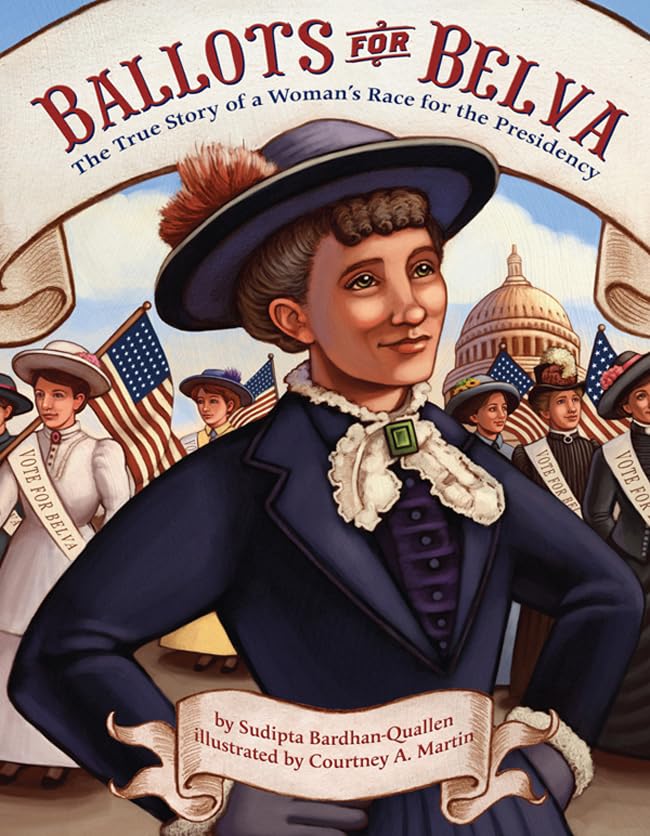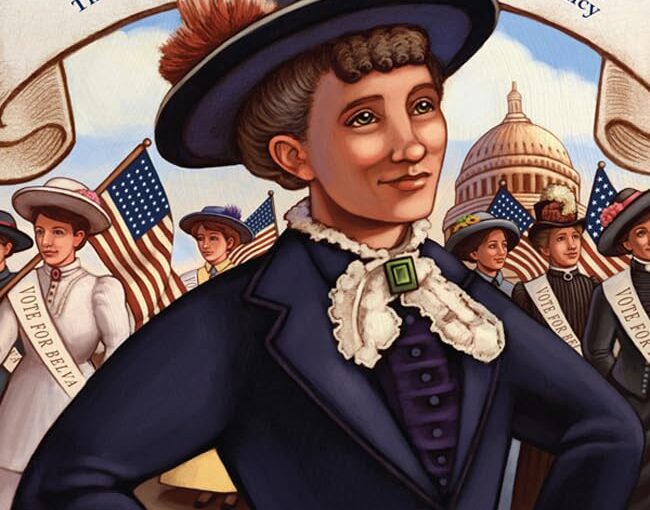This book will not interest me because the main character’s name is Belva. At one point that name was probably super popular, but then it became something that’s more associated with crackers. Ballots for Belva seems like that, but it is very fascinating, educational, and eventually, entertaining. It’s especially so for know-it-all people, elementary school kids or those who are otherwise looking for the exception to every rule. It’s a non-fiction, illustrated book highlighting the first woman to complete a presidential election cycle and receive votes. That’s a complex way to describe it and exposes the issues of being a book about ‘the first (insert blank here) to…..’, but Ballots for Belva addresses those weaknesses, and moves on from them to deliver a concrete story that we can all hopefully put behind us.

I
n the 1830s Belva Lockwood wanted more. She had graduated from college but wanted to be a lawyer, but law schools at the time didn’t admit women as students. Of the three law schools she applied to, only one of them wrote back, and that was just to tell her that her presence there would distract the male students, and thus she was denied. However, the National University Law School had just opened and was admitting women, and she was one of the 14 others to attend that year. Unfortunately, the school made it frustrating for them by not allowing them to take the same classes and even refused to give them their diplomas when they successfully completed their coursework.
Lockwood wrote to President Ulysses S. Grant, who was also the president of National University Law School, notified him of the situation and her diploma was received a couple of days later. She went on to help a black attorney do the same thing, practiced law, became a public speaker and women’s rights activist. In 1884 she decided to run for the President of the United States, even though women weren’t allowed to vote.
Back then the ballots to vote weren’t provided to you. It was the responsibility of each political party to print their own ballots, campaign across the county, put on parades and get her platform stances out to the voters. The press ridiculed her and Election Day came with her not going to the polls, because women couldn’t vote then. She received votes in nine of the 38 states totaled 4,711 popular votes. After the tally was completed is was discovered that many votes for her had been thrown away or attributed to other candidates.
Ballots for Belva is an illustrated book that tells the top layer of a story and opens it up to a larger, non-fiction conversation for elementary school ages. At first glance, you might think that there’s too much text for those young readers. However, try to think of Ballots for Belva as a read-aloud book and that’s where it can really shine. It can be read in just under ten minutes and opens up those ages to some great conversation that resonates today.
Logic-based conversations will also pay attention to the fact that Lockwood was the first woman to run for President and receive votes, but 12 years prior to her another woman ran for President. That was Victoria Woodhull, who ran for President, but had to abandon her campaign because it ran out of money, due to the aforementioned expenses of printing ballots and campaigning. So, who was the first woman to run for President? That is just one of the fun talking points that you can have with grades five through seven as they debate this query and you muse about how things can change and stay the same, all at the same time. As a book, Ballots for Belva is an easy-to-read, as well as, talk about, look at the first successful woman candidate for President and a glance at how elections were conducted in the United States in the late 1800s.
*I used to live in Charlotte, a large city that had an embarrassing picture column that ran whenever someone would take the paper to an exotic destination. It’s the Charlotte paper in Bangkok! Here’s a picture of the paper on the Great Wall of China. This was in the early 90’s, prior to social media and the impending death of newspapers. I was having a conversation with one of their photojournalists at the time and we both hung our shook our heads in embarrassment that even acknowledging this was worthy of being a thing. I view being the first whoever to do whatever in the same category. It’s boring and I look forward to the time when we all can evaluate people on their performance, rather than for or against them based on factors that they were born with, rather than their skill or intelligence, a factor that’s sorely lacking in all politics today.
Ballots for Belva: The True Story of a Woman’s Race for the Presidency is by Sudipta Bardham-Quallen with illustrations by Courtney A. Martin and is available on Abrams Books for Young Readers. It was originally released in 2008.
There are affiliate links in this post.





 Facebook
Facebook Twitter
Twitter Flickr
Flickr GooglePlus
GooglePlus Youtube
Youtube